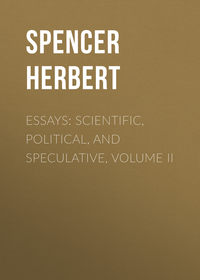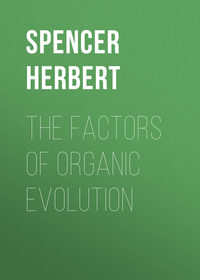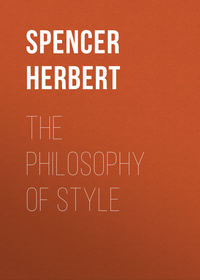 полная версия
полная версияThe Principles of Biology, Volume 1 (of 2)
Among these elements out of which living bodies are built, there is an unusual tendency to unite in multiples; and so to form groups of products which have the same chemical elements in the same proportions, but, differing in their modes of aggregation, possess different properties. This prevalence among them of isomerism and polymerism, shows, in another way, the special fitness of organic substances for undergoing re-distributions of their components.
In those most complex compounds that are instrumental to vital actions, there exists a kind and degree of molecular mobility which constitutes the plastic quality fitting them for organization. Instead of the extreme molecular mobility possessed by three out of the four organic elements in their separate states – instead of the diminished, but still great, molecular mobility possessed by their simpler combinations, the gaseous and liquid characters of which unfit them for showing to any extent the process of Evolution – instead of the physical properties of their less simple combinations, which, when not made unduly mobile by heat, assume the unduly rigid form of crystals; we have in these colloids, of which organisms are mainly composed, just the required compromise between fluidity and solidity. They cannot be reduced to the unduly mobile conditions of liquid and gas; and yet they do not assume the unduly fixed condition usually characterizing solids. The absence of power to unite together in polar arrangement, leaves their molecules with a certain freedom of relative movement, which makes them sensitive to small forces, and produces plasticity in the aggregates composed of them.
While the relatively great inertia of these large and complex organic molecules renders them comparatively incapable of being set in motion by the ethereal undulations, and so reduced to less coherent forms of aggregation, this same inertia facilitates changes of arrangement among their constituent molecules or atoms; since, in proportion as an incident force impresses but little motion on a mass, it is the better able to impress motion on the parts of the mass in relation to one another. And it is further probable that the extreme contrasts in molecular mobilities among the components of these highly complex molecules, aid in producing modifiability of arrangement among them.
Lastly, the great difference in diffusibility between colloids and crystalloids, makes possible in the tissues of organisms a specially rapid re-distribution of matter and motion; both because colloids, being easily permeable by crystalloids, can be chemically acted on throughout their whole masses, instead of only on their surfaces; and because the products of decomposition, being also crystalloids, can escape as fast as they are produced: leaving room for further transformations. So that while the composite molecules of which organic tissues are built up, possess that low molecular mobility fitting them for plastic purposes, it results from the extreme molecular mobilities of their ultimate constituents, that the waste products of vital activity escape as fast as they are formed.
To all which add that the state of warmth, or increased molecular vibration, in which all the higher organisms are kept, increases these various facilities for re-distribution: not only as aiding chemical changes, but as accelerating the diffusion of crystalloid substances.
CHAPTER II.
THE ACTIONS OF FORCES ON ORGANIC MATTER
§ 10. To some extent, the parts of every body are changed in their arrangement by any incident mechanical force. But in organic bodies, and especially in animal bodies, the changes of arrangement produced by mechanical forces are usually conspicuous. It is a distinctive mark of colloids that they readily yield to pressures and tensions, and that they recover, more or less completely, their original shapes, when the pressures or tensions cease. Evidently without this pliability and elasticity, most organic actions would be impossible. Not only temporary but also permanent alterations of form are facilitated by this colloid character of organic matter. Continued pressure on living tissue, by modifying the processes going on in it (perhaps retarding the absorption of new material to replace the old that has decomposed and diffused away), gradually diminishes and finally destroys its power of resuming the outline it had at first. Thus, generally speaking, the substances composing organisms are modifiable by arrested momentum or by continuous strain, in far greater degrees than are inorganic substances.
§ 11. Sensitiveness to certain forces which are quasi-mechanical, if not mechanical in the usual sense, is seen in two closely-related peculiarities displayed by organic matter as well as other matter which assumes the same state of molecular aggregation.
Colloids take up by a power called "capillary affinity," a large quantity of water: undergoing at the same time great increase of bulk with change of form. Conversely, with like readiness, they give up this water by evaporation; resuming, partially or completely, their original states. Whether resulting from capillarity, or from the relatively great diffusibility of water, or from both, these changes are to be here noted as showing another mode in which the arrangements of parts in organic bodies are affected by mechanical actions.
In what is termed osmose, we have a further mode of an allied kind. When on opposite sides of a permeable septum, and especially a septum of colloidal substance, are placed miscible solutions of different densities, a double transfer takes place: a large quantity of the less dense solution finds its way through the septum into the more dense solution; and a small quantity of the more dense finds its way into the less dense – one result being a considerable increase in the bulk of the more dense at the expense of the less dense. This process, which appears to depend on several conditions, is not yet fully understood. But be the explanation what it may, the process is one that tends continually to work alterations in organic bodies. Through the surfaces of plants and animals, transfers of this kind are ever taking place. Many of the conspicuous changes of form undergone by organic germs, are due mainly to the permeation of their limiting membranes by the surrounding liquids.
It should be added that besides the direct alterations which the imbibition and transmission of water and watery solutions by colloids produce in organic matter, they produce indirect alterations. Being instrumental in conveying into the tissues the agents of chemical change, and conveying out of them the products of chemical change, they aid in carrying on other re-distributions.
§ 12. As elsewhere shown (First Principles, § 100) heat, or a raised state of molecular vibration, enables incident forces more easily to produce changes of molecular arrangement in organic matter. But besides this, it conduces to certain vital changes in so direct a way as to become their chief cause.
The power of the organic colloids to imbibe water, and to bring along with it into their substance the materials which work transformations, would not be continuously operative if the water imbibed were to remain. It is because it escapes, and is replaced by more water containing more materials, that the succession of changes is maintained. Among the higher animals and higher plants its escape is facilitated by evaporation. And the rate of evaporation is, other things equal, determined by heat. Though the current of sap in a tree is partly dependent on some action, probably osmotic, that goes on in the roots; yet the loss of water from the surfaces of the leaves, and the consequent absorption of more sap into the leaves by capillary attraction, must be a chief cause of the circulation. The drooping of a plant when exposed to the sunshine while the earth round its roots is dry, shows us how evaporation empties the sap-vessels; and the quickness with which a withered slip revives on being placed in water, shows us the part which capillary action plays. In so far, then, as the evaporation from a plant's surface helps to produce currents of sap through the plant, we must regard the heat which produces this evaporation as a part-cause of those re-distributions of matter which these currents effect. In terrestrial animals, heat, by its indirect action as well as by its direct action, similarly aids the changes that are going on. The exhalation of vapour from the lungs and the surface of the skin, forming the chief escape of the water that is swallowed, conduces to the maintenance of those currents through the tissues without which the functions would cease. For though the vascular system distributes nutritive liquids in ramified channels through the body; yet the absorption of these liquids into tissues, partly depends on the escape of liquids which the tissues already contain. Hence, to the extent that such escape is facilitated by evaporation, and this evaporation facilitated by heat, heat becomes an agent of re-distribution in the animal organism.6
§ 13. Light, which is now known to modify many inorganic compounds – light, which works those chemical changes utilized in photography, causes the combinations of certain gases, alters the molecular arrangements of many crystals, and leaves traces of its action even on substances that are extremely stable, – may be expected to produce marked effects on substances so complex and unstable as those which make up organic bodies. It does produce such effects; and some of them are among the most important that organic matter undergoes.
The molecular changes wrought by light in animals are of but secondary moment. There is the darkening of the skin that follows exposure to the Sun's rays. There are those alterations in the retina which cause in us sensations of colours. And on certain eyeless creatures that are semi-transparent, the light permeating their substance works some effects evinced by movements. But speaking generally, the opacity of animals limits the action of light to their surfaces; and so renders its direct physiological influence but small.7 On plants, however, the solar rays that produce in us the impression of yellow, are the immediate agents of those molecular changes through which are hourly accumulated the materials for further growth. Experiments have shown that when the Sun shines on living leaves, they begin to exhale oxygen and to accumulate carbon and hydrogen – results which are traced to the decomposition, by the solar rays, of the carbonic acid and water absorbed. It is now an accepted conclusion that, by the help of certain classes of the ethereal undulations penetrating their leaves, plants are enabled to separate from the associated oxygen those two elements of which their tissues are chiefly built up.
This transformation of ethereal undulations into certain molecular re-arrangements of an unstable kind, on the overthrow of which the stored-up forces are liberated in new forms, is a process that underlies all organic phenomena. It will therefore be well if we pause a moment to consider whether any proximate interpretation of it is possible. Researches in molecular physics give us some clue to its nature.
The elements of the problem are these: – The atoms8 of several ponderable matters exist in combination: those which are combined having strong affinities, but having also affinities less strong for some of the surrounding atoms that are otherwise combined. The atoms thus united, and thus mixed among others with which they are capable of uniting, are exposed to the undulations of a medium that is so rare as to seem imponderable. These undulations are of numerous kinds: they differ greatly in their lengths, or in the frequency with which they recur at any given point. And under the influence of undulations of a certain frequency, some of these atoms are transferred from atoms for which they have a stronger affinity, to atoms for which they have a weaker affinity. That is to say, particular orders of waves of a relatively imponderable matter, remove particular atoms of ponderable matter from their attachments, and carry them within reach of other attachments. Now the discoveries of Bunsen and Kirchoff respecting the absorption of particular luminiferous undulations by the vapours of particular substances, joined with Prof. Tyndall's discoveries respecting the absorption of heat by gases, show very clearly that the atoms of each substance have a rate of vibration in harmony with ethereal waves of a certain length, or rapidity of recurrence. Every special kind of atom can be made to oscillate by a special order of ethereal waves, which are absorbed in producing its oscillations; and can by its oscillations generate this same order of ethereal waves. Whence it appears that immense as is the difference in density between ether and ponderable matter, the waves of the one can set the atoms of the other in motion, when the successive impacts of the waves are so timed as to correspond with the oscillations of the atoms. The effects of the waves are, in such case, cumulative; and each atom gradually acquires a momentum made up of countless infinitesimal momenta. Note, further, that unless the members of a chemically-compound molecule are so bound up as to be incapable of any relative movements (a supposition at variance with the conceptions of modern science) we must conceive them as severally able to vibrate in unison or harmony with those same classes of ethereal waves that affect them in their uncombined states. While the compound molecule as a whole will have some new rate of oscillation determined by its attributes as a whole; its components will retain their original rates of oscillation, subject only to modifications by mutual influence. Such being the circumstances of the case we may partially understand how the Sun's rays can effect chemical decompositions. If the members of a diatomic molecule stand so related to the undulations falling on them, that one is thrown into a state of increased oscillation and the other not; it is manifest that there must arise a tendency towards the dislocation of the two – a tendency which may or may not take effect, according to the weakness or strength of their union, and according to the presence or absence of collateral affinities. This inference is in harmony with several significant facts. Dr. Draper remarks that "among metallic substances (compounds) those first detected to be changed by light, such as silver, gold, mercury, lead, have all high atomic weights; and such as sodium and potassium, the atomic weights of which are low, appeared to be less changeable." As here interpreted, the fact specified amounts to this; that the compounds most readily decomposed by light, are those in which there is a marked contrast between the atomic weights of the constituents, and probably therefore a marked contrast between the rapidities of their vibrations. The circumstance, too, that different chemical compounds are decomposed or modified in different parts of the spectrum, implies that there is a relation between special orders of undulations and special orders of molecules – doubtless a correspondence between the rates of these undulations and the rates of oscillation which some of the components of such molecules will assume. Strong confirmation of this view may be drawn from the decomposing actions of those longer ethereal waves which we perceive as heat. On contemplating the whole series of diatomic compounds, we see that the elements which are most remote in their atomic weights, as hydrogen and the noble metals generally, will not combine at all, or do so with great difficulty: their vibrations are so unlike that they cannot keep together under any conditions of temperature. If, again, we look at a smaller group, as the metallic oxides, we see that whereas those metals which have atoms nearest in weight to the atoms of oxygen, cannot be separated from oxygen by heat, even when it is joined by a powerful collateral affinity; those metals which differ more widely from oxygen in their atomic weights, can be de-oxidized by carbon at high temperatures; and those which differ from it most widely combine with it very reluctantly, and yield it up if exposed to thermal undulations of moderate intensity. Here indeed, remembering the relations among the atomic weights in the two cases, may we not suspect a close analogy between the de-oxidation of a metallic oxide by carbon under the influence of the longer ethereal waves, and the de-carbonization of carbonic acid by hydrogen under the influence of the shorter ethereal waves?
These conceptions help us to some dim notion of the mode in which changes are wrought in light in the leaves of plants. Among the several elements concerned, there are wide differences in molecular mobility, and probably in the rates of molecular vibration. Each is combined with one of the others, but is capable of forming various combinations with the rest. And they are severally in presence of a complex compound into which they all enter, and which is ready to assimilate with itself the new compound molecules they form. Certain of the ethereal waves falling on them when thus arranged, cause a detachment of some of the combined atoms and a union of the rest. And the conclusion suggested is that the induced vibrations among the various atoms as at first arranged, are so incongruous as to produce instability, and to give collateral affinities the power to work a rearrangement which, though less stable under other conditions, is more stable in the presence of these particular undulations. There seems, indeed, no choice but to conceive the matter thus. An atom united with one for which it has a strong affinity, has to be transferred to another for which it has a weaker affinity. This transfer implies motion. The motion is given by the waves of a medium that is relatively imponderable. No one wave of this imponderable medium can give the requisite motion to this atom of ponderable matter: especially as the atom is held by a positive force besides its inertia. The motion required can hence be given only by successive waves; and that these may not destroy each other's effects, it is needful that each shall strike the atom just when it has completed the recoil produced by the impact of previous ones. That is, the ethereal undulations must coincide in rate with the oscillations of the atom, determined by its inertia and the forces acting on it. It is also requisite that the rate of oscillation of the atom to be detached, shall differ from that of the atom with which it is united; since if the two oscillated in unison the ethereal waves would not tend to separate them. And, finally, the successive impacts of the ethereal waves must be accumulated until the resulting oscillations have become so wide in their sweep as greatly to weaken the cohesion of the united atoms, at the same time that they bring one of them within reach of other atoms with which it will combine. In this way only does it seem possible for such a force to produce such a transfer. Moreover, while we are thus enabled to conceive how light may work these molecular changes, we also gain an insight into the method by which the insensible motions propagated to us from the Sun, are treasured up in such ways as afterwards to generate sensible motions. By the accumulation of infinitesimal impacts, atoms of ponderable matter are made to oscillate. The quantity of motion which each of them eventually acquires, effects its transfer to a position of unstable equilibrium, from which it can afterwards be readily dislodged. And when so dislodged, along with other atoms similarly and simultaneously affected, there is suddenly given out all the motion which had been before impressed on it.
Speculation aside, however, that which it concerns us to notice is the broad fact that light is an all-important agent of molecular changes in organic substances. It is not here necessary for us to ascertain how light produces these compositions and decompositions. It is necessary only for us to observe that it does produce them. That the characteristic matter called chlorophyll, which gives the green colour to leaves, makes its appearance whenever the blanched shoots of plants are exposed to the Sun; that the petals of flowers, uncoloured while in the bud, acquire their bright tints as they unfold; and that on the outer surfaces of animals, analogous changes are induced; are wide inductions which are enough for our present purpose.
§ 14. We come next to the agency of chief importance among those that work changes in organic matter; namely, chemical affinity. How readily vegetal and animal substances are modified by other substances put in contact with them, we see daily illustrated. Besides the many compounds which cause the death of an organism into which they are put, we have the much greater number of compounds which work those milder effects termed medicinal – effects implying, like the others, molecular re-arrangements. Indeed, most soluble chemical compounds, natural and artificial, produce, when taken into the body, alterations that are more or less manifest in their results.
After what was shown in the last chapter, it will be manifest that this extreme modifiability of organic matter by chemical agencies, is the chief cause of that active molecular re-arrangement which organisms, and especially animal organisms, display. In the two fundamental functions of nutrition and respiration, we have the means by which the supply of materials for this active molecular re-arrangement is maintained.
The process of animal nutrition consists partly in the absorption of those complex substances which are thus highly capable of being chemically altered, and partly in the absorption of simpler substances capable of chemically altering them. The tissues always contain small quantities of alkaline and earthy salts, which enter the system in one form and are excreted in another. Though we do not know specifically the parts which these salts play, yet from their universal presence, and from the transformations which they undergo in the body, it may be safely inferred that their chemical affinities are instrumental in working some of the metamorphoses ever going on.
The inorganic substance, however, on which mainly depend these metamorphoses in organic matter, is not swallowed along with the solid and liquid food, but is absorbed from the surrounding medium – air or water, as the case may be. Whether the oxygen taken in, either, as by the lowest animals, through the general surface, or, as by the higher animals, through respiratory organs, is the immediate cause of those molecular changes which are ever going on throughout the living tissues; or whether the oxygen, playing the part of scavenger, merely aids these changes by carrying away the products of decompositions otherwise caused; it equally remains true that these changes are maintained by its instrumentality. Whether the oxygen absorbed and diffused through the system effects a direct oxidation of the organic colloids which it permeates, or whether it first leads to the formation of simpler and more oxidized compounds, which are afterwards further oxidized and reduced to still simpler forms, matters not, in so far as the general result is concerned. In any case it holds good that the substances of which the animal body is built up, enter it in either an unoxidized or in a but slightly oxidized and highly unstable state; while the great mass of them leave it in a fully oxidized and stable state. It follows, therefore, that, whatever the special changes gone through, the general process is a falling from a state of unstable chemical equilibrium to a state of stable chemical equilibrium. Whether this process be direct or indirect, the total molecular re-arrangement and the total motion given out in effecting it, must be the same.
§ 15. There is another species of re-distribution among the component matters of organisms, which is not immediately effected by the affinities of the matters concerned, but is mediately effected by other affinities; and there is reason to think that the re-distribution thus caused is important in amount, if not indeed the most important. In ordinary cases of chemical action, the two or more substances concerned themselves undergo changes of molecular arrangement; and the changes are confined to the substances themselves. But there are other cases in which the chemical action going on does not end with the substances at first concerned, but sets up chemical actions, or changes of molecular arrangement, among surrounding substances that would else have remained quiescent. And there are yet further cases in which mere contact with a substance that is itself quiescent, will cause other substances to undergo rapid metamorphoses. In what we call fermentation, the first species of this communicated chemical action is exemplified. One part of yeast, while itself undergoing molecular change, will convert 100 parts of sugar into alcohol and carbonic acid; and during its own decomposition, one part of diastase "is able to effect the transformation of more than 1000 times its weight of starch into sugar." As illustrations of the second species, may be mentioned those changes which are suddenly produced in many colloids by minute portions of various substances added to them – substances that are not undergoing manifest transformations, and suffer no appreciable effects from the contact. The nature of the first of these two kinds of communicated molecular change, which here chiefly concerns us, may be rudely represented by certain visible changes communicated from mass to mass, when a series of masses has been arranged in a special way. The simplest example is that furnished by the child's play of setting bricks on end in a row, in such positions that when the first is overthrown it overthrows the second, the second the third, the third the fourth, and so on to the end of the row. Here we have a number of units severally placed in unstable equilibrium, and in such relative positions that each, while falling into a state of stable equilibrium, gives an impulse to the next sufficient to make the next, also, fall from unstable to stable equilibrium. Now since, among mingled compound molecules, no one can undergo change in the arrangement of its parts without a molecular motion that must cause some disturbance all round; and since an adjacent molecule disturbed by this communicated motion, may have the arrangement of its constituent atoms altered, if it is not a stable arrangement; and since we know, both that the molecules which are changed by this so-called catalysis are unstable, and that the molecules resulting from their changes are more stable; it seems probable that the transformation is really analogous, in principle, to the familiar one named. Whether thus interpretable or not, however, there is good reason for thinking that to this kind of action is due a large amount of vital metamorphosis. Let us contemplate the several groups of facts which point to this conclusion.9









